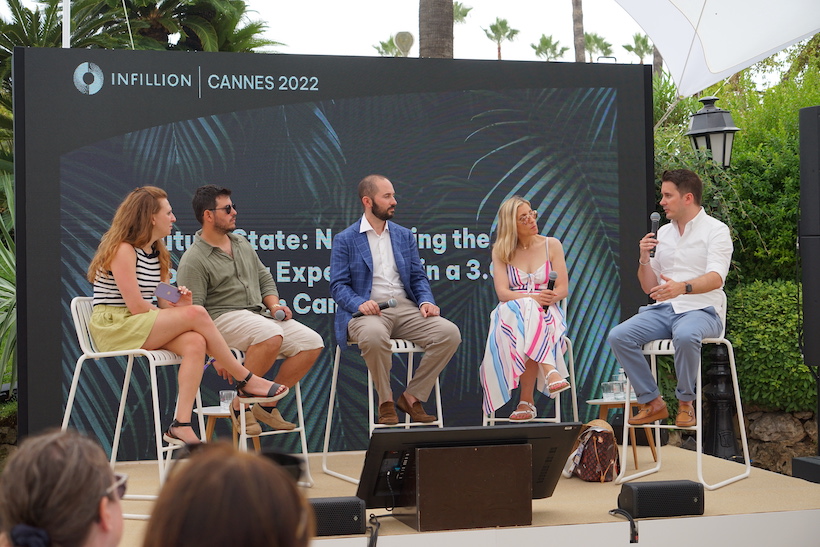This article was originally published on Campaign.
For marketers and brands, the metaverse presents many exciting opportunities for creative and consumer experiences as we start to move beyond Web 1.0 and 2.0 to 3.0. To do that, brands need to start thinking differently about building these experiences and how they can help power the consumer journey in an authentic and immersive way.
At the Infillion Garden in Cannes, France, Alison Weissbrot, editor at Campaign US, moderated a panel of experts including Ben Fenster, cofounder and chief product officer at Anzu: Patrick Gales, SVP of business development at Infillion; Gabrielle Heyman, head of global brand partnerships at Zynga; and Erik Murphy-Chutorian, VP of engineering at Niantic, on the next generation of gaming and consumer entertainment.
Defining Where We Are
“Any kind of experience where people are online together and communicating is a metaverse,” Fenster kicked off things by explaining. At Niantic, the focus is on “the real-world metaverse,” Murphy-Chutorian said. “People will walk around the real world, see things in the environment around them and through a mixture of games and utility and discovery, find content that’s overlaid on the physical world.”
The next phase is “what we could be doing as we step into these virtual worlds,” Gales added. “It might be gaming, education or music-based experiences.”
In the gaming world, “it’s very important to be authentic to the game and listen to your gaming partner,” noted Heyman, cautioning, “my advice is to play it yourself because gamers have a very opinionated perspective and if you do it wrong, they will be vocal on social.” On the flip side, she added, “if you do it right, it’s an amazing brand halo.”
Integrating Into Immersive Experiences
“People like to express themselves in the games they play,” said Murphy-Chutorian. For example, “if you have avatars, you can decorate them with the brands you associate yourselves with.” Advertisers can generate “more brand loyalty if it’s opt-in and ultimately create branded value for people in the metaverse.”
Fenster explained that “gaming is the gateway into the metaverse because you use the same tools and technologies to create the metaverse.” Exploring the gaming world is “a way to get the right perspective around how these people interact within that environment and how to find meaningful ways to engage with them.” As an example, he noted that American Eagle started by “creating a virtual tennis game” within Roblox’s Livetopia where “avatars could play with the characters.”
Another successful starting point, Murphy-Chutorian added, are sponsored locations within Pokémon Go. “It allows brands to mark areas of the map that become Poké-stops, have branded experiences and can drive foot traffic to those locations, which is great for new brick-and-mortar.” In addition, with billboard balloons, “there’s an opportunity to get an in-game reward by participating in advertisements and then an upsell opportunity to learn more about products or get coupons.”
Engaging Through Rewarded Advertising
The focus at Infillion, Gales explained, is on rewarded advertising. “What we’re building today are experiences for users that will allow for just that: alternatives to a pay wall or wallet, where you can start earning tokens and then make purchases within these virtual worlds.”
What traditionally “used to be called watch-to-earn in gaming” is “play-to-earn in the Web 3.0,” added Heyman. “Hardcore gamers and a lot of engineering gaming talent is a bit dubious of Web 3.0 because of this idea that you can lose money on crypto.” She added that play-to-earn is important “for brands getting into the space because it takes away some of the risk factors.”
“A lot of what we’re working through is the translation of that NFT across a variety of spaces,” said Gales. “That could be as basic as a couponing experience.” For example, if Coke were a sponsor, a gamer could earn a digital coupon to use in the real world.
“This kind of immersive type of ad units becomes part of the experience and makes it a bit better,” added Fenster. “Brands can start using data to curate the right audience, understand what works and plan for more advanced activations.”

At the Infillion Garden in Cannes, France, Alison Weissbrot, editor at Campaign US; Ben Fenster, cofounder and chief product officer at Anzu; Patrick Gales, SVP of business development at Infillion; Gabrielle Heyman, head of global brand partnerships at Zynga; and Erik Murphy-Chutorian, VP of engineering at Niantic.
Working with the Creators
“It’s important to match the audience you’re going after with the environment that you’re in,” said Heyman. “That’s the biggest disconnect of Web 3.0 right now.” Before jumping in, understand “what kind of a brand you are: Are you an early adopter? Do you have a high-value tech product?” Then, “personalize the ads.”
A creator can develop a branded avatar as “part of the chat feature and when you use that avatar, that creator earns more direct revenue than by just being in the background of his screen and having a bunch of eyeballs on there that wouldn’t have done anything,” explained Gales.
Brands can collaborate with creators, Fenster added, “to build the experiment and experiences in their games and not try to do everything from scratch because they are the experts, they understand the media best.”
“The most popular games people play are created by individuals who see an ability to economically build games and platforms that help build branded experiences that live in the right location into this metaverse,” added Murphy-Chutorian.
As a brand, “do you want to be interactive and in a game where you’re having this two-way conversation, or do you want to be this sponsor of content that’s around and adjacent to?” concluded Heyman. “We have a really exciting opportunity to build in from scratch.”
Follow Infillion for Cannes Lions 2022 Recaps
Want more Cannes Lions 2022 content? This is one of the four panels that we’ll be sharing, so make sure to follow Infillion on Linkedin and Twitter.
Check out our other panel recaps:

